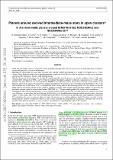Files in this item
Planets around evolved intermediate-mass stars II. Are there really planets around IC 4651 No. 9122, NGC 2423 No. 3, and NGC 4349 No. 127?
Item metadata
| dc.contributor.author | Delgado Mena, E. | |
| dc.contributor.author | Lovis, C. | |
| dc.contributor.author | Santos, N. C. | |
| dc.contributor.author | Gomes da Silva, J. | |
| dc.contributor.author | Mortier, A. | |
| dc.contributor.author | Tsantaki, M. | |
| dc.contributor.author | Sousa, S. G. | |
| dc.contributor.author | Figueira, P. | |
| dc.contributor.author | Cunha, M. S. | |
| dc.contributor.author | Campante, T. L. | |
| dc.contributor.author | Adibekyan, V. | |
| dc.contributor.author | Faria, J. P. | |
| dc.contributor.author | Montalto, M. | |
| dc.date.accessioned | 2018-07-27T12:30:07Z | |
| dc.date.available | 2018-07-27T12:30:07Z | |
| dc.date.issued | 2018-11 | |
| dc.identifier | 255070833 | |
| dc.identifier | 3c76ad5a-1fae-4387-bad2-125803f687bb | |
| dc.identifier | 85056133415 | |
| dc.identifier | 000448955300002 | |
| dc.identifier.citation | Delgado Mena , E , Lovis , C , Santos , N C , Gomes da Silva , J , Mortier , A , Tsantaki , M , Sousa , S G , Figueira , P , Cunha , M S , Campante , T L , Adibekyan , V , Faria , J P & Montalto , M 2018 , ' Planets around evolved intermediate-mass stars II. Are there really planets around IC 4651 No. 9122, NGC 2423 No. 3, and NGC 4349 No. 127? ' , Astronomy & Astrophysics , vol. 619 , A2 . https://doi.org/10.1051/0004-6361/201833152 | en |
| dc.identifier.issn | 0004-6361 | |
| dc.identifier.other | BibCode: 2018arXiv180709608D | |
| dc.identifier.uri | https://hdl.handle.net/10023/15717 | |
| dc.description | Funding: AM acknowledges funding from the European Union Seventh Framework Programme (FP7/2007-2013) under grant agreement number 313014 (ETAEARTH). | en |
| dc.description.abstract | Aims. The aim of this work is to search for planets around intermediate-mass stars in open clusters using data from an extensive survey with more than 15 yr of observations. Methods. We obtain high-precision radial velocities (RV) with the HARPS spectrograph for a sample of 142 giant stars in 17 open clusters. We fit Keplerian orbits when a significant periodic signal is detected. We also study the variation of stellar activity indicators and line-profile variations to discard stellar-induced signals. Results. We present the discovery of a periodic RV signal compatible with the presence of a planet candidate in the 1.15 Gyr open cluster IC 4651 orbiting the 2.06 M⊙ star No. 9122. If confirmed, the planet candidate would have a minimum mass of 7.2 MJ and a period of 747 days. However, we also find that the full width at half maximum (FWHM) of the cross-correlation function (CCF) varies with a period close to the RV, casting doubts on the planetary nature of the signal. We also provide refined parameters for the previously discovered planet around NGC 2423 No. 3, but show evidence that the bisector inverse slope (BIS) of the CCF is correlated with the RV during some of the observing periods. We consider this fact as a warning that this might not be a real planet and that the RV variations could be caused by stellar activity and/or pulsations. Finally, we show that the previously reported signal by a brown dwarf around NGC 4349 No. 127 is presumably produced by stellar activity modulation. Conclusions. The long-term monitoring of several red giants in open clusters has allowed us to find periodic RV variations in several stars. However, we also show that the follow-up of this kind of stars should last more than one orbital period to detect long-term signals of stellar origin. This work highlights the fact that although it is possible to detect planets around red giants, large-amplitude, long-period RV modulations do exist in such stars that can mimic the presence of an orbiting planetary body. Therefore, we need to better understand how such RV modulations behave as stars evolve along the red giant branch and perform a detailed study of all the possible stellar-induced signals (e.g., spots, pulsations, granulation) to comprehend the origin of RV variations. | |
| dc.format.extent | 13 | |
| dc.format.extent | 1395011 | |
| dc.language.iso | eng | |
| dc.relation.ispartof | Astronomy & Astrophysics | en |
| dc.subject | Stars: individual: IC 4651 No. 9122 | en |
| dc.subject | Stars: individual: NGC 2423 No. 3 | en |
| dc.subject | Stars: individual: NGC 4349 No. 127 | en |
| dc.subject | Planetary systems | en |
| dc.subject | Planets and satellites: detection | en |
| dc.subject | Open clusters and associations: general | en |
| dc.subject | QB Astronomy | en |
| dc.subject | QC Physics | en |
| dc.subject | 3rd-DAS | en |
| dc.subject.lcc | QB | en |
| dc.subject.lcc | QC | en |
| dc.title | Planets around evolved intermediate-mass stars II. Are there really planets around IC 4651 No. 9122, NGC 2423 No. 3, and NGC 4349 No. 127? | en |
| dc.type | Journal article | en |
| dc.contributor.sponsor | European Commission | en |
| dc.contributor.institution | University of St Andrews. School of Physics and Astronomy | en |
| dc.contributor.institution | University of St Andrews. St Andrews Centre for Exoplanet Science | en |
| dc.identifier.doi | 10.1051/0004-6361/201833152 | |
| dc.description.status | Peer reviewed | en |
| dc.identifier.url | http://adsabs.harvard.edu/abs/2018arXiv180709608D | en |
| dc.identifier.grantnumber | en |
This item appears in the following Collection(s)
Items in the St Andrews Research Repository are protected by copyright, with all rights reserved, unless otherwise indicated.

